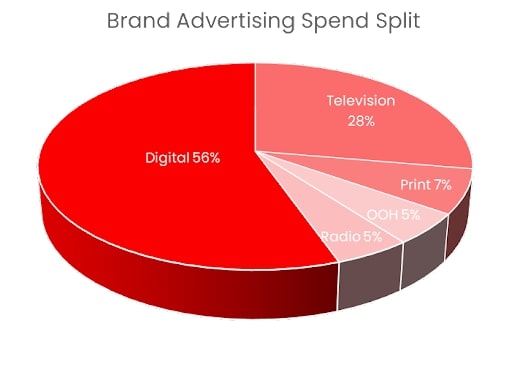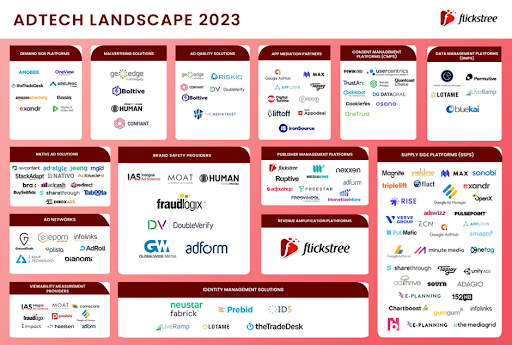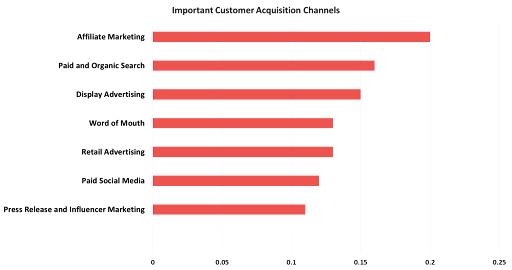Internet searches around “how to make money online” has been amongst the top searches globally and has been on a constant rise. E-commerce and Digital Purchases by consumers have grown by 10.4 percent in last 5 years. (source: Forbes)
This has paved the way for brands willing to sell online and also spend online. So much so that today digital spends by brands contributes to over 50% of marketing spends, globally. Every dollar spent online can be tracked, and that makes this medium “the Top Favourite” marketing channel.
In sum, Brands are willing to spend online, till the time they are able to get the desired returns on their spends.

Source : eMarketer, Goldman Sachs report
The Actors in the Digital Industry – The Science and The Art
Over a decade ago, the rise in Digital trend gave rise to the AdTech Industry. Soon the AdTech platforms became the hero of a brand, who would get them customers.
And then came the supporting cast – the ad copy, ad creatives & targeting different audience segments, and different copies and creatives for different audience segments. They all started to play an equally important role in an ad’s success. The support cast was no longer a support but started taking the CenterStage. And soon it was evident that AdTech is Science and is an Art! Maybe more of an art, than Science. The Science was giving data to the marketers to decide what’s working best and what’s not and the art was enabling marketers to become more creative and gather more data across different touchpoints.
This gave rise to a host of companies that would enable a brand to do the Science and the Art better. And so, it gave opportunities to many players whose key role was to enable the brands optimize their spends across AdTech Platforms.
Two business models emerged and continue to thrive
- CPM, Cost Per Mile (1000 impressions), or
- CPC, Cost Per Click, in anticipation that these clicks will convert into sales and revenue.
However, the Return on Ad Spend (ROAS) remains pretty uncertain in these models, as brands keep experimenting with the ad copy, creatives and targeting to deliver, constantly. Brands were looking for a business model that gives more certainty on ROAS, in a controlled environment – entered Affiliate Marketing – over the last decade or so.

Affiliate Marketing – the Simplifier and the Amplifier
Affiliate Marketing allowed brands to pay their traffic providers only when their digital objectives were met – like sales and conversions. A series of brand partners, or affiliates, came forward and proposed to brands – “I shall send you relevant traffic and you pay me only if my traffic meets your objective.” And also came along the tracking-and-attribution companies who said – “I will let you know which partner of yours sent the relevant traffic to you so that you can pay them correctly.”
This lit up the eyes of digitally selling brands, as –
- Their Ad spends now could have a pre-determined Return on Ad Spend, as brands would fix a certain commission on sales to pay their affiliates,
- Brand’s Working Capital could now be better managed, as they would pay off the affiliates using customer money and not from their marketing budget,
- Brands could work with multiple affiliates as traffic providers, without any upfront cost to them. It also gave brands a diversified reach beyond their regular marketing mix
This gave the emergence of newer cost models, or let’s say, profit models.
- CPS – Cost-per-Sale, here the brand pays a pre-established amount everytime there is a sale on their website or app, by the affiliate’s traffic
- CPL – Cost-per-Lead, here the brand pays a pre-established amount for every lead generated, by the affiliate’s traffic
- CPR – Cost-per-Registration, here the brand pays a pre-established amount when a new customer registers on their website / app, by the affiliate’s traffic
- CPI – Cost-per-Install, here the brand pays a pre-established amount everytime their app gets Installed, by the affiliate’s traffic
- CPD – Cost-per-Deposit, here the brand pays a pre-established amount everytime there is a deposit done by a customer, by the affiliate’s traffic
Affiliate marketing soon became a top favourite for many brands, globally!
The Affiliate Marketing Funnel

Source : Gartner, IIFL Research
Affiliate Marketing is now the Fastest Growing Sales Channel
As per Today, brands spend 17Bn USD annually as commission, to their affiliate partners and this value is growing at 20% CAGR.
Over 80% of brands now use affiliate marketing programs. 15% of the digital media
industry’s income comes from affiliate marketing.

Source : DemandSage 2023 Affiliate Marketing Statistics
For 20% of brand marketers, affiliate marketing stands out as their primary customer acquisition channel.

Source : DemandSage 2023 Affiliate Marketing Statistics
This multi-billion dollar thriving affiliate marketing industry is providing amazing opportunities for online entrepreneurs. While the industry shall evolve and grow, it throws a great opportunity for those users who are searching for “how to make money online” more than any other channel. The ones who have already started riding on this bandwagon will continue to evolve and flourish.
I start this blog series on means and ways to work efficiently in this thriving affiliate marketing industry. I will try to crystal-gaze how the industry evolves from here. I will thus capture how brands, affiliates, and intermediaries can work together and create a win-win-win ecosystem to flourish together. I will also capture how AI is going to change the future of this industry and the role Flickstree is playing in bringing about this change.


